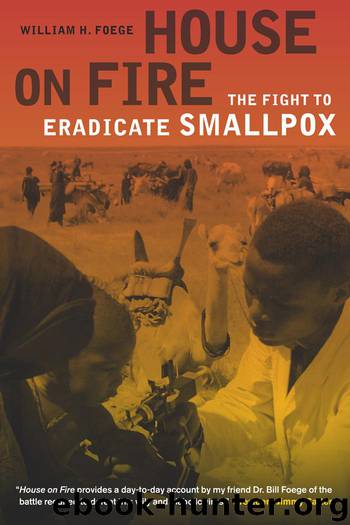House on Fire by William H. Foege

Author:William H. Foege
Language: eng
Format: mobi, epub
ISBN: 9780520948891
Publisher: University of California Press
Published: 2014-08-12T12:54:45.985000+00:00
Map 2. Northern India
TRAINING THE TEAMS
By October, the smallpox leadership team had organized the first searches in Uttar Pradesh, Bihar, and West Bengal. That matter-of-fact statement disguises an incredible amount of work accomplished by a huge army of people. From the beginning, extremes dominated the work in India. First was the heat, which for much of the year was stifling, a fact of life that had to be ignored to be endured. A second factor was the size of the population, which was well beyond the experience of any U.S. public health worker. In 1973, Uttar Pradesh had 88 million people in fifty-four districts; Bihar had 56 million in seventeen districts (later thirty-one, as the state reorganized during the campaign). A third was the population density. While related of course to population numbers, the crowding factor presented challenges of its own. The areas of highest smallpox transmission in India were also the areas of highest population density. In many districts, the goal of 80 percent vaccination coverage through mass vaccination risked leaving more people susceptible to smallpox in every square mile than would be found in the United States if no one was vaccinated.1
What exactly was a search? The specifics varied by state and time, but searches were usually conducted monthly in the endemic states. For the six days of the typical search, a vast team comprising every health worker available (except those designated for the containment work that would follow) was mobilized to help find cases of smallpox. At the end of the six days, the daily hires were released, people working in other programs such as malaria and family planning went back to their regular responsibilities, and most of the other smallpox searchers were deployed to augment the containment teams.
A state meeting was scheduled to take place about two weeks after the search. This allowed enough time to assemble and digest the reports and prepare for the meeting, where refinements would be made for the next search, scheduled for one or two weeks later. The ministry and WHO staff worked quickly to develop guidelines as well as the forms required to implement those guidelines. A high level of trust and efficiency soon developed among the individuals involved.
Planning a search required developing a search protocol to be followed in an entire state, including estimates of personnel requirements at each level. Health officers could then arrange to borrow as many workers as possible from other programs and hire day laborers to make up the difference. We also developed model operational guides for both smallpox-endemic states and non-endemic areas.
Training courses were required at every organizational level. A training session was held in New Delhi for the health officers who would be overseeing smallpox operations in each state. This was followed by training sessions in each state for representatives of all the districts in the state. These district officers would then hold training sessions for each public health center (PHC, or block) in their district.
Each district had, on average, twenty such health centers with about one hundred thousand people in the catchment area for each center.
Download
This site does not store any files on its server. We only index and link to content provided by other sites. Please contact the content providers to delete copyright contents if any and email us, we'll remove relevant links or contents immediately.
Periodization Training for Sports by Tudor Bompa(8171)
Why We Sleep: Unlocking the Power of Sleep and Dreams by Matthew Walker(6618)
Paper Towns by Green John(5092)
The Immortal Life of Henrietta Lacks by Rebecca Skloot(4526)
The Sports Rules Book by Human Kinetics(4296)
Dynamic Alignment Through Imagery by Eric Franklin(4118)
ACSM's Complete Guide to Fitness & Health by ACSM(3989)
Kaplan MCAT Organic Chemistry Review: Created for MCAT 2015 (Kaplan Test Prep) by Kaplan(3940)
Introduction to Kinesiology by Shirl J. Hoffman(3726)
Livewired by David Eagleman(3685)
The Death of the Heart by Elizabeth Bowen(3553)
The River of Consciousness by Oliver Sacks(3542)
Alchemy and Alchemists by C. J. S. Thompson(3451)
Bad Pharma by Ben Goldacre(3357)
Descartes' Error by Antonio Damasio(3231)
The Emperor of All Maladies: A Biography of Cancer by Siddhartha Mukherjee(3068)
The Gene: An Intimate History by Siddhartha Mukherjee(3049)
The Fate of Rome: Climate, Disease, and the End of an Empire (The Princeton History of the Ancient World) by Kyle Harper(3006)
Kaplan MCAT Behavioral Sciences Review: Created for MCAT 2015 (Kaplan Test Prep) by Kaplan(2941)
